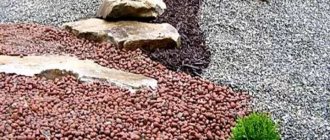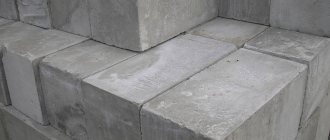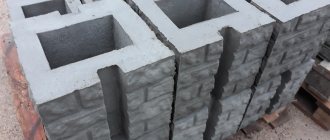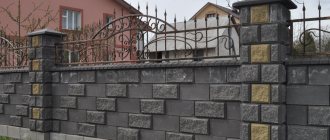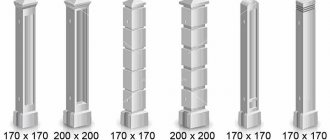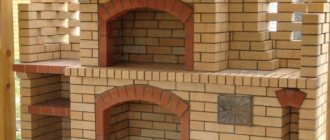GOST 6665-91
INTERSTATE STANDARD
CONCRETE AND REINFORCED CONCRETE EDGE STONES
Specifications
IPC PUBLISHING HOUSE OF STANDARDS Moscow
INTERSTATE STANDARD
| CONCRETE AND REINFORCED CONCRETE EDGE STONES Specifications Concrete and reinforced concrete curbs. Specifications | GOST 6665-91 |
Date of introduction 01/01/92
This standard applies to concrete and reinforced concrete side stones (hereinafter referred to as stones), made from fine-grained (sand) and heavy concrete in accordance with GOST 26633 in the climatic modification UHL in accordance with GOST 15150, intended for separating the roadway of streets and roads from sidewalks, lawns, platforms and etc.
ACCEPTANCE
2.1. Stones are accepted in batches in accordance with GOST 13015.1 and this standard.
2.2. Stones accepted:
- based on the results of periodic tests - in terms of strength, crack resistance, frost resistance, water absorption;
- based on the results of acceptance tests - according to strength indicators (class of concrete in terms of compressive strength, transfer and tempering strength), compliance of reinforcement products with this standard, strength of welded joints, accuracy of geometric parameters, thickness of the protective layer of concrete to the reinforcement, crack opening width, category concrete surface, grade for workability of the concrete mixture, volume of entrained air in concrete mixtures with air-entraining additives.
2.3. Periodic loading tests of prestressed stones to control their strength and crack resistance, as well as to determine the tensile strength of concrete in bending, are carried out before the start of mass production of stones and subsequently - when making design changes to them, changing manufacturing technology and quality of materials in accordance with GOST requirements 13015.1.
In the process of mass production of stones, tests for crack resistance by loading, as well as tensile strength during bending, are carried out at least once every 6 months.
2.4. Concrete stones are tested for frost resistance and water absorption when mastering production, changing the nominal composition of concrete, technology, type and quality of materials, but at least once every 6 months.
2.5. The workability of the concrete mixture is checked at least once per shift.
2.6. The volume of entrained air in concrete mixtures with air-entraining additives is checked at least once per shift.
2.7. Stones in terms of the accuracy of geometric parameters, the thickness of the protective layer of concrete to the reinforcement, the location of the reinforcement, the presence of mounting loops, the category of the concrete surface and the width of the opening of technological cracks should be taken based on the results of random inspection in accordance with Table. 5 for stones made of heavy concrete and in accordance with table. 6 - for stones made of fine-grained concrete, made using the vibrocompression method.
Table 5
PC.
| Batch size | First sample size | Second sample size | Rejection number | |
| for the first sample | for two samples | |||
| Up to 90 | 3 | 3 | 1 | 2 |
| From 91 to 150 | 5 | 5 | 1 | 2 |
| » 151 » 280 | 8 | 8 | 1 | 2 |
| » 281 » 500 | 13 | 13 | 3 | 4 |
| » 501 » 1200 | 20 | 20 | 4 | 5 |
| » 1201 » 3200 | 32 | 32 | 6 | 7 |
| St. 3200 | 50 | 50 | 8 | 9 |
Table 6
PC.
| Batch size | Sample size | Rejection number |
| Up to 1200 | 5 | 2 |
| St. 1200 | 8 | 3 |
A batch of stones not accepted based on the results of sampling must be accepted individually. In this case, the acceptance of stones must be carried out according to the indicators for which the batch was not accepted.
The possibility of using stones that do not meet the criteria for strength and frost resistance is established by the design organization.
2.8. The strength of concrete stones is monitored according to GOST 18105.
2.9. The consumer has the right to carry out a control check of the compliance of the stones specified in the order with the requirements of this standard.
2.10. Quality document - according to GOST 13015.3. The quality document must include the frost resistance grade of the concrete and the water absorption characteristics of the concrete.
At the consumer’s request, the results of control tests of stones for strength and crack resistance according to GOST 8829 are included in the quality document.
Production manufacturing
Industrial technology for the production of borders separates natural stone blocks from concrete forms. Requirements for the first type are regulated in GOST 32018–12. Natural stone is an excellent material; granite elements resist moisture and are durable. Natural borders are produced by sawing or split into elements of suitable sizes. The products are finished by polishing or fired using special equipment. The material is expensive and is used only in significant road construction projects.
READ Concrete M350: general characteristics and features of use
Concrete and reinforced concrete products are produced in several ways , while the dimensions of the road curb are maintained in accordance with the standards:
- pouring concrete mixture into prepared smooth formwork;
- production of injection molded elements subject to vibration ;
- release of stones that are subjected to vibration simultaneously with pressing.
The first two methods are used in the manufacture of material in small enterprises or at home. The third method requires special equipment, which is unprofitable to purchase in small-scale production.
The size of the curbs affects the composition of the mixture.
Long (more than 1 meter) elements are made of fine-grained sand and aggregate. Such stones are in some cases reinforced with reinforcement. Reinforcement is necessarily used for solid curbs from 3 to 6 m long, which are made from heavy types of concrete. To make such road barriers, special equipment is required. Vibrocompression is an advanced method. The products are distinguished by high physical properties and are used for the manufacture of curb elements on important expressways, bridges, and intercity routes. Using a brick making machine, the production process is automated and productivity increases. The components of the mixture are supplied to the installation, and mixing of the solution, pressing, vibrating and packaging is carried out by the equipment operator in automatic mode.
Sequence of production cycles:
- the conveyor loads the amount of sand, cement, filler and water specified by the program into the mixing container;
- the concrete mixer forms the concrete mixture as a result of rotation;
- the required amount of solution is supplied to the mold;
- the mold is subjected to vibration, and the pressure force compresses the material;
- the conveyor transfers the forms to the chamber, where the elements gain strength;
- An automatic palletizer collects and places finished products on pallets or in bundles.
READ Production and use of concrete grade M250, strength class B20
CONTROL METHODS
3.1. Load testing of stones to control their strength and crack resistance is carried out according to GOST 8829.
The diagram and position of the stone during testing are shown in Fig. 1 and in table. 7.
R -
control load.
Crap. 1
Table 7
| Brand of stone | Position of the stone during testing | l , mm | A, mm |
| BR300.30.15 | 3000 | 750 | |
| BR300.30.18 | |||
| BR300.45.18 | |||
| BR300.60.20 | |||
| BR600.30.15-A-IV | 6000 | 1500 | |
| BR600.30.18-A-IV | |||
| BR600.45.18-A-IV (AV) | |||
| BR600.60.20-A-IV (AV) | |||
| BU 300.30.29 | 3000 | 750 | |
| BUP300.30.32 | |||
| BUP300.30.29 | |||
| BUP300.30.32 | |||
| BUP600.30.32 | 6000 | 1500 |
The maximum width of crack opening when testing for strength and crack resistance should not exceed 0.2 mm.
Load testing of stones is carried out after the stones reach compressive strength at 28 days of age.
3.2. The compressive and tensile strength of concrete during bending should be determined according to GOST 10180 or GOST 17624, or GOST 22690.
When producing stones using the vibrocompression method, which leads to a change in the composition of concrete, a correction factor is adopted for the strength of concrete of control samples, established experimentally in accordance with the requirements of GOST 10180. In this case, the correction factor should be taken at least 1.
3.3. Frost resistance of concrete is determined according to GOST 10060.0 - GOST 10060.4 or GOST 26134 by saturating concrete stone samples before testing with a 5% aqueous solution of sodium chloride.
In this case, a decrease in the compressive strength of concrete samples is allowed by no more than 5% and a loss of their mass by no more than 3%.
3.4. Water absorption of concrete stones is determined according to GOST 12730.3.
3.5. The workability of the concrete mixture is determined according to GOST 10181.
3.6. The volume of entrained air in a concrete mixture with air-entraining additives is controlled according to GOST 10181.
3.7. Inspection of welded reinforcement products should be carried out in accordance with GOST 10922 and GOST 23858.
3.8. The tension force of the reinforcement, controlled at the end of the tension, is measured according to GOST 22362.
3.9. The dimensions and position of reinforcement products in stone, the thickness of the protective layer of concrete before the reinforcement should be determined according to GOST 17625 or GOST 22904.
In the absence of the necessary instruments, it is possible to determine the specified parameters by cutting grooves and exposing the reinforcement of the stone, followed by sealing the grooves and places where the reinforcement is exposed with fine-grained concrete or the concrete from which the stone is made.
3.10. Dimensions, deviations from straightness and perpendicularity of stones, the width of opening of technological cracks, the dimensions of shells, sagging and edges of concrete should be checked by the methods established by GOST 26433.0 and GOST 26433.1.
The length of curved stones is measured along the upper edge of the convex side, and the deviation of the front surface profile from the nominal curvature is checked with a template.
Ask a Question
Checkout
The frequently used definition of “ curb stone ” implies the construction terms “ curb ” and “ side stone ”. The border is produced in accordance with the technical specifications of GOST 6665-91.
Curb stone is used in the manufacture of road surfaces as a material that separates the main elements of the road surface from each other. It protects the edge of the road surface from destructive influences and helps strengthen the main part of the road surface and extend its service life. In addition, it performs decorative functions and can also serve as a marking of the beginning and end of a certain road zone.
The advantages of this building material are strength and durability at a relatively low cost, as well as versatility: thanks to its aesthetic characteristics and the ability to choose colors, it can fit harmoniously and naturally into any design project.
The scope of application of curbs is quite wide: it is used on roads, in parks, squares, and suburban areas.
Depending on the application, borders are divided into the following types:
— For road construction. Used as strengthening and fencing of the roadway from the lawn, from the stopping area or from the sidewalk; for arranging driveways and parking lots, they can also serve as a drainage system - for the construction of guide water drains from the road. A type of road curbs are main curbs, which are used on highways and long-distance routes. Road curbs are characterized by an increased level of strength.
— For landscaping areas (so-called sidewalk or garden borders). They are used for artistic decoration of both the entire area and individual landscape elements (for example, fencing flower beds), for zoning the territory both in urban construction and on a garden plot. Since their main function is decorative, they have a fairly wide range of color variations.
The area of use of curb stone determines its performance characteristics, because it is constantly subjected to high intensive loads. Therefore, the main requirement for the manufacturing material is durability and resistance to mechanical loads.
GOST 6665-91 “Concrete and reinforced concrete side stones” regulates the following technical characteristics of side stones depending on the brand:
— class of concrete depending on tensile strength during bending; — concrete class depending on compressive strength; — strength and crack resistance; - water absorption; - frost resistance.
Side stones can be made from fine-grained or heavy concrete. The practical strength of concrete, depending on the rated indicators, should be determined in accordance with GOST 18105. At the same time, for a curb length of 1.0 m made of fine-grained concrete, it is recommended to use vibrocompression technology. Curbs 3.0 and 6.0 m long are made of heavy concrete using reinforcement. The concrete composition is selected in accordance with the recommendations of GOST 27006 and established industry requirements and recommendations. Water-cement ratio - no more than 0.40. Concrete mixtures according to GOST 7473 are prepared using air-entraining additives.
Curbs and side stones are marked in accordance with GOST 6665-91 according to the following scheme:
XX 1. 2. 3. 4
where XX is the designation of the type of stone; 1 – number indicating length (cm); 2 - number indicating height (cm); 3 - number indicating width (cm); 4 – radius of curvature (may be absent). In addition, the class of prestressed reinforcement can be indicated through a dash sign.
By type, side stones are divided into:
- BR - direct privates; — BU — straight with widening; — BUP — straight with intermittent widening; - BV - entry; - BL - straight with tray; - BC - curvilinear.
The type, size and shape of the border determine its area of use.
If we talk about the cost of a curb stone, it depends on the technical characteristics and its purpose. Accordingly, sidewalk curbs are more economical with sufficient strength and durability, which makes their use universal.
| BR-50-20-8 Dimensions (L x W x H in mm): 500x200x80 Weight (in kg): 20 |
| BR-80-20-8 Dimensions (L x W x H in mm): 800x200x80 Weight (in kg): 26 |
| BR-80-30-15 Dimensions (L x W x H in mm): 800x300x150 Weight (in kg): 85 |
| BR-100-20-8 Dimensions (L x W x H in mm): 1000x200x80 Weight (in kg): 40 |
| BR-100-30-15 Dimensions (L x W x H in mm): 1000x300x150 Weight (in kg): 100 |
| BR-100-30-18 Dimensions (L x W x H in mm): 1000x300x180 Weight (in kg): 120 |
| BR-100-45-15 Dimensions (L x W x H in mm): 1000x450x150 Weight (in kg): 145 |
| BR-100-45-18 Dimensions (L x W x H in mm): 1000x450x180 Weight (in kg): 190 |
| BR-100-60-18 Dimensions (L x W x H in mm): 1000x600x180 Weight (in kg): 220 |
| BR-150-30-15 Dimensions (L x W x H in mm): 1500x300x150 Weight (in kg): 160 |
| BR-300-30-15 Dimensions (L x W x H in mm): 3000x300x150 Weight (in kg): 315 |
| BR-300-45-18 Dimensions (L x W x H in mm): 3000x450x180 Weight (in kg): 580 |
| BR-300-60-20 Dimensions (L x W x H in mm): 3000x600x200 Weight (in kg): 880 |
Ask a Question
Checkout
TRANSPORTATION AND STORAGE
4.1. Stones are transported by any type of transport in accordance with the requirements of GOST 9288 and “Technical conditions for loading and securing cargo.”
Stones in open cars and on trucks should be transported in container packages in accordance with GOST 20259 or on pallets in accordance with GOST 18343, bandaged with steel tape in accordance with GOST 3560 or wire in accordance with GOST 3282, ensuring rigid fixation and safety of the stones.
4.2. It is prohibited to load stones in bulk and unload them by dropping them.
4.3. Stones should be stored in a finished product warehouse, sorted by grade in stacks or bags up to 2 m high.
4.4. Stones in stacks must be laid on wooden pads with a thickness of at least 30 mm according to TU 400-1-225 or pads made of other materials that ensure the safety of the stones, located vertically one below the other at a distance of 0.2 the length of the stone from the end. The bottom row of stones should be laid on transverse spacers with a width of at least 80 mm.


